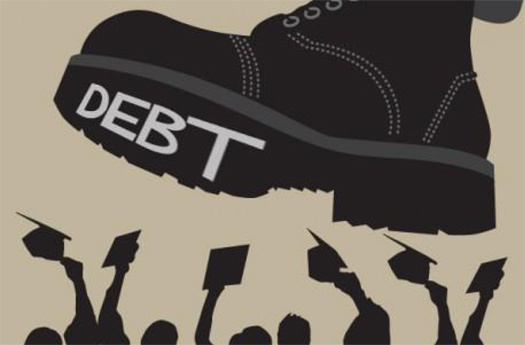Student Debt is basically the killer from an 80s slasher movie.
It can’t be killed, it will come back to haunt you decades after it stopped being relevant, and it wants to punish you for having fun. If you’re planning to shed your student debt by dying or declaring bankruptcy, I have some bad news for you. The loan you signed up for when you were too young to vote can often follow you and your bereaved loved ones forever. The sooner you give in, cut all leisure and luxury from your life to focus on paying off those debts, the sooner you’ll be free.
But what about these Democrats running for office now? Some of them—just two, really—are coming out with some pretty radical new policies about debt forgiveness. It would be foolish to put all that time and energy into paying off debt that might just disappear if you can wait it out another year and change. And don’t forget the money—all that sweet, delicious money. So, with the national burden of student debt approaching two trillion dollars, should you get to work unburdening yourself from the crippling weight of debt you were basically tricked into when you were too young to know better, or should you bet on a leftward political shift to rescue you? To figure out your chances, we need to break down each prominent candidate’s position on student debt and figure out their likelihood of actually getting it done.
 Bernie Sanders
Bernie Sanders
Bernie comes first, because he’s too often ignored, and because his plan for student debt is the most aggressive. If Bernie has his way, all the student debt in the country is going out the window. Wipe the slate clean. It’s like it never happened. If you’re currently failing to pay off debt from multiple expensive degrees, Bernie is your best hope. He polls consistently well—with only Biden’s fading star outshining him—and he’s the only candidate with no restrictions or limitations on student debt forgiveness.
If you’re feeling the Bern so much that you aren’t concerned about how his legislation could get passed in Congress, you might as well take out some more loans and get another degree while you wait. But just to play devil’s advocate, even if Bernie gets the nomination and wins the presidency, it’s unlikely that most of his major proposals will get through. He’s prioritizing Medicare For All, so unless student debt somehow gets bundled up with healthcare, a whole lot of political willpower is likely to be expended before anyone considers letting you off the hook. And even then, Bernie’s plan is so much better for the powerless than for the powerful that you have to know that Congress would do their best to chop it up into much more of a compromise. So… probably don’t start taking out any new loans just yet.
 Elizabeth Warren
Elizabeth Warren
Speaking of compromise, say hello to everyone’s favorite not-quite-Bernie. Warren hasn’t done quite as well in the polls as Sanders, but she’s done an impressive job of chiseling out a serious spot in the top tier of contenders—far left of Biden, but noticeably more centrist than Bernie—and is generally considered to have some momentum in the polls, though that seems to be waning. As for student debt forgiveness, Warren’s plan is nearly as extensive as Bernie’s, with some notable exceptions.
Warren’s plan would forgive up to $50,000 of your student debt if your household makes $100,000/year or less. Above that amount, the forgiveness begins to taper off, and it wouldn’t cover members of households making $250,000/year at all. So if you went to NYU, you’ll probably still have a lot of debt left—especially if you still live with your rich parents. That said, around 95% of people with student debt would have it eliminated, so it would also need to be knee-capped by centrist legislators who just want to keep everything stable by making sure that rich people don’t get any less rich. Fortunately, with Warren’s focus being on her wealth tax proposal, it’s a bit easier to imagine student debt being folded into the first round of Congressional activity under a Warren presidency.
 Joe Biden
Joe Biden
Joe Biden is not going to do much for your private loans. Maybe he’ll make it easier to refinance, but don’t expect forgiveness. He does, however, have a plan for federal loans. If the government paid for your education, and you’re paying off your loans with an Income-Based Repayment plan, Biden wants to cut your payment rates in half, from 10% of “discretionary” income—income above a certain basic threshold—down to 5%. If you make these payments for 20 years, any remaining debt is forgiven, which could be a lot under this new structure.
So if you’re willing to wait two decades to have only federal student debt erased, Joe might work out for you. Assuming he maintains his precarious front-runner status—despite his consign poor debate performances and the minimal enthusiasm of his supporters—this more moderate plan could be in your future. On the other hand, it’s still a Democrat’s policy proposal, and Republican legislators would therefore treat it as full-blown communist takeover and do everything they can to cripple it. So unless you trust Biden to make it a legislative priority, don’t expect much.
 The Underdogs
The Underdogs
There are way too many other candidates to go through all their plans here, and most likely none of them have a chance. Pete Buttigieg has a ton of student debt himself, but he still prefers to focus on refinancing and cutting future costs. Andrew Yang has suggested a federal buyout of private loans, so you can pay them off to the government at less predatory rates, and he also wants to give you money every month so you stop complaining. Julian Castro wants to offer partial loan forgiveness for people who receive public assistance benefits for three out of five years. And Kamala Harris would offer up to $20,000 of debt forgiveness… if you received a Pell Grant…and you start your own business…that lasts at least three years…in a disadvantaged community. So no one you’ve ever met will qualify.
Whether their plans would do much to alleviate the student debt crisis or whether they’d be viable in Congress are both moot points, because none of these people are going to win the Democratic nomination, let alone the presidency.
 Donald Trump
Donald Trump
The only kind of debt forgiveness Donald Trump cares about is the kind that involves nine zeroes, and allows him to keep putting his name on stuff. He will not help you unless he directly benefits from helping you. He is a broken man, and you and everyone you know do not exist in Donald Trump’s world outside of your value to him personally. He will tell you what you want to hear, and then give you nothing. Still, nearly half the country loves him, and that portion that does matters more than the rest of us every four years, so he stands a pretty good chance of being reelected.
With that in mind, it’s probably a good idea to keep paying off your student debt. Minimum payments can work if you’re crossing your fingers for 2020, but if you stop paying you will destroy your credit and risk having your wages garnished—AKA gruesomely slashed. Ouch.
string(10388) "
Student Debt is basically the killer from an 80s slasher movie.
It can't be killed, it will come back to haunt you decades after it stopped being relevant, and it wants to punish you for having fun. If you're planning to shed your student debt by dying or declaring bankruptcy, I have some bad news for you. The loan you signed up for when you were too young to vote can often follow you and your bereaved loved ones forever. The sooner you give in, cut all leisure and luxury from your life to focus on paying off those debts, the sooner you'll be free.
But what about these Democrats running for office now? Some of them—just two, really—are coming out with some pretty radical new policies about debt forgiveness. It would be foolish to put all that time and energy into paying off debt that might just disappear if you can wait it out another year and change. And don't forget the money—all that sweet, delicious money. So, with the national burden of student debt approaching two trillion dollars, should you get to work unburdening yourself from the crippling weight of debt you were basically tricked into when you were too young to know better, or should you bet on a leftward political shift to rescue you? To figure out your chances, we need to break down each prominent candidate's position on student debt and figure out their likelihood of actually getting it done.
 Bernie Sanders
Bernie SandersBernie comes first, because he's too often ignored, and because his plan for student debt is the most aggressive. If Bernie has his way, all the student debt in the country is going out the window. Wipe the slate clean. It's like it never happened. If you're currently failing to pay off debt from multiple expensive degrees, Bernie is your best hope. He polls consistently well—with only Biden's fading star outshining him—and he's the only candidate with no restrictions or limitations on student debt forgiveness.
If you're feeling the Bern so much that you aren't concerned about how his legislation could get passed in Congress, you might as well take out some more loans and get another degree while you wait. But just to play devil's advocate, even if Bernie gets the nomination and wins the presidency, it's unlikely that most of his major proposals will get through. He's prioritizing Medicare For All, so unless student debt somehow gets bundled up with healthcare, a whole lot of political willpower is likely to be expended before anyone considers letting you off the hook. And even then, Bernie's plan is so much better for the powerless than for the powerful that you have to know that Congress would do their best to chop it up into much more of a compromise. So... probably don't start taking out any new loans just yet.
 Elizabeth Warren
Elizabeth WarrenSpeaking of compromise, say hello to everyone's favorite not-quite-Bernie. Warren hasn't done quite as well in the polls as Sanders, but she's done an impressive job of chiseling out a serious spot in the top tier of contenders—far left of Biden, but noticeably more centrist than Bernie—and is generally considered to have some momentum in the polls, though that seems to be waning. As for student debt forgiveness, Warren's plan is nearly as extensive as Bernie's, with some notable exceptions.
Warren's plan would forgive up to $50,000 of your student debt if your household makes $100,000/year or less. Above that amount, the forgiveness begins to taper off, and it wouldn't cover members of households making $250,000/year at all. So if you went to NYU, you'll probably still have a lot of debt left—especially if you still live with your rich parents. That said, around 95% of people with student debt would have it eliminated, so it would also need to be knee-capped by centrist legislators who just want to keep everything stable by making sure that rich people don't get any less rich. Fortunately, with Warren's focus being on her wealth tax proposal, it's a bit easier to imagine student debt being folded into the first round of Congressional activity under a Warren presidency.
 Joe Biden
Joe BidenJoe Biden is not going to do much for your private loans. Maybe he'll make it easier to refinance, but don't expect forgiveness. He does, however, have a plan for federal loans. If the government paid for your education, and you're paying off your loans with an Income-Based Repayment plan, Biden wants to cut your payment rates in half, from 10% of "discretionary" income—income above a certain basic threshold—down to 5%. If you make these payments for 20 years, any remaining debt is forgiven, which could be a lot under this new structure.
So if you're willing to wait two decades to have only federal student debt erased, Joe might work out for you. Assuming he maintains his precarious front-runner status—despite his consign poor debate performances and the minimal enthusiasm of his supporters—this more moderate plan could be in your future. On the other hand, it's still a Democrat's policy proposal, and Republican legislators would therefore treat it as full-blown communist takeover and do everything they can to cripple it. So unless you trust Biden to make it a legislative priority, don't expect much.
 The Underdogs
The UnderdogsThere are way too many other candidates to go through all their plans here, and most likely none of them have a chance. Pete Buttigieg has a ton of student debt himself, but he still prefers to focus on refinancing and cutting future costs. Andrew Yang has suggested a federal buyout of private loans, so you can pay them off to the government at less predatory rates, and he also wants to give you money every month so you stop complaining. Julian Castro wants to offer partial loan forgiveness for people who receive public assistance benefits for three out of five years. And Kamala Harris would offer up to $20,000 of debt forgiveness... if you received a Pell Grant...and you start your own business...that lasts at least three years...in a disadvantaged community. So no one you've ever met will qualify.
Whether their plans would do much to alleviate the student debt crisis or whether they'd be viable in Congress are both moot points, because none of these people are going to win the Democratic nomination, let alone the presidency.
 Donald Trump
Donald TrumpThe only kind of debt forgiveness Donald Trump cares about is the kind that involves nine zeroes, and allows him to keep putting his name on stuff. He will not help you unless he directly benefits from helping you. He is a broken man, and you and everyone you know do not exist in Donald Trump's world outside of your value to him personally. He will tell you what you want to hear, and then give you nothing. Still, nearly half the country loves him, and that portion that does matters more than the rest of us every four years, so he stands a pretty good chance of being reelected.
With that in mind, it's probably a good idea to keep paying off your student debt. Minimum payments can work if you're crossing your fingers for 2020, but if you stop paying you will destroy your credit and risk having your wages garnished—AKA gruesomely slashed. Ouch.
"

 Bernie Sanders
Bernie Sanders Elizabeth Warren
Elizabeth Warren Joe Biden
Joe Biden The Underdogs
The Underdogs Donald Trump
Donald Trump










